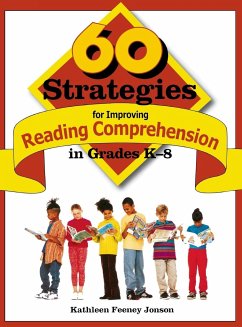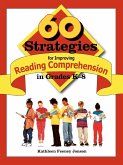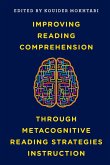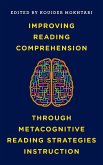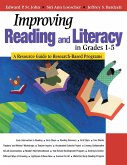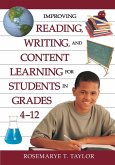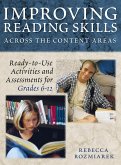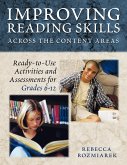Kathleen Feeney Jonson
60 Strategies for Improving Reading Comprehension in Grades K-8
Kathleen Feeney Jonson
60 Strategies for Improving Reading Comprehension in Grades K-8
- Gebundenes Buch
- Merkliste
- Auf die Merkliste
- Bewerten Bewerten
- Teilen
- Produkt teilen
- Produkterinnerung
- Produkterinnerung
This ready-to-use tool kit of fun and functional strategies, based on the National Reading Panel Report, helps teach the most difficult piece of the reading process: comprehension.
Andere Kunden interessierten sich auch für
![60 Strategies for Improving Reading Comprehension in Grades K-8 60 Strategies for Improving Reading Comprehension in Grades K-8]() Kathleen Feeney Jonson60 Strategies for Improving Reading Comprehension in Grades K-844,99 €
Kathleen Feeney Jonson60 Strategies for Improving Reading Comprehension in Grades K-844,99 €![Improving Reading Comprehension through Metacognitive Reading Strategies Instruction Improving Reading Comprehension through Metacognitive Reading Strategies Instruction]() Improving Reading Comprehension through Metacognitive Reading Strategies Instruction73,99 €
Improving Reading Comprehension through Metacognitive Reading Strategies Instruction73,99 €![Improving Reading Comprehension through Metacognitive Reading Strategies Instruction Improving Reading Comprehension through Metacognitive Reading Strategies Instruction]() Improving Reading Comprehension through Metacognitive Reading Strategies Instruction137,99 €
Improving Reading Comprehension through Metacognitive Reading Strategies Instruction137,99 €![Improving Reading and Literacy in Grades 1-5 Improving Reading and Literacy in Grades 1-5]() Edward P. St. JohnImproving Reading and Literacy in Grades 1-542,99 €
Edward P. St. JohnImproving Reading and Literacy in Grades 1-542,99 €![Improving Reading, Writing, and Content Learning for Students in Grades 4-12 Improving Reading, Writing, and Content Learning for Students in Grades 4-12]() Rosemarye T. TaylorImproving Reading, Writing, and Content Learning for Students in Grades 4-1232,99 €
Rosemarye T. TaylorImproving Reading, Writing, and Content Learning for Students in Grades 4-1232,99 €![Improving Reading Skills Across the Content Areas Improving Reading Skills Across the Content Areas]() Rebecca RozmiarekImproving Reading Skills Across the Content Areas89,99 €
Rebecca RozmiarekImproving Reading Skills Across the Content Areas89,99 €![Improving Reading Skills Across the Content Areas Improving Reading Skills Across the Content Areas]() Rebecca RozmiarekImproving Reading Skills Across the Content Areas42,99 €
Rebecca RozmiarekImproving Reading Skills Across the Content Areas42,99 €-
-
-
This ready-to-use tool kit of fun and functional strategies, based on the National Reading Panel Report, helps teach the most difficult piece of the reading process: comprehension.
Hinweis: Dieser Artikel kann nur an eine deutsche Lieferadresse ausgeliefert werden.
Hinweis: Dieser Artikel kann nur an eine deutsche Lieferadresse ausgeliefert werden.
Produktdetails
- Produktdetails
- Verlag: Corwin
- Seitenzahl: 242
- Erscheinungstermin: 21. Dezember 2005
- Englisch
- Abmessung: 286mm x 221mm x 18mm
- Gewicht: 879g
- ISBN-13: 9780761988373
- ISBN-10: 0761988378
- Artikelnr.: 22331639
- Herstellerkennzeichnung
- Libri GmbH
- Europaallee 1
- 36244 Bad Hersfeld
- gpsr@libri.de
- Verlag: Corwin
- Seitenzahl: 242
- Erscheinungstermin: 21. Dezember 2005
- Englisch
- Abmessung: 286mm x 221mm x 18mm
- Gewicht: 879g
- ISBN-13: 9780761988373
- ISBN-10: 0761988378
- Artikelnr.: 22331639
- Herstellerkennzeichnung
- Libri GmbH
- Europaallee 1
- 36244 Bad Hersfeld
- gpsr@libri.de
In her 40 years as an educator, Kathleen Feeney Jonson, Professor Emeritus, has been a teacher, taught director of staff development, principal, director of curriculum and instruction, and university faculty. She conducted numerous workshops for teachers and administrators on such topics as reading comprehension strategies, writing process, portfolio assessment, peer coaching, and beginning teacher assistance programs. Until her retirement in summer 2009, Jonson was professor of education and coordinator of the Master in Arts in Teaching Reading program at the University of San Franciscös School of Education. She published three books with Corwin Press, including The New Elementary Teacher¿s Handbook (1st edition 1997, 2nd edition 2001), Being an Effective Mentor: How to Help Beginning Teachers Succeed (1st edition 2002, 2nd edition 2007), and 60 Strategies for Improving Reading Comprehension in Grades K-8 (2006).
Preface
About the Author
Strategy 1: ABC Book
Strategy 2: Anticipation Guide
Strategy 3: Bio Poem
Strategy 4: Book Box
Strategy 5: Brainstorming
Strategy 6: Bumper Stickers
Strategy 7: Central Story Problem
Strategy 8: Character Bag
Strategy 9: Character Mapping
Strategy 10: Creating Chapter Titles
Strategy 11: Crossword Puzzle
Strategy 12: Cubing
Strategy 13: Directed Reading Thinking Activity
Strategy 14: Double-Entry Journal
Strategy 15: Exclusion Brainstorming
Strategy 16: Fishbowl
Strategy 17: Found Poem
Strategy 18: Four-Corners Debate
Strategy 19: Gallery Walk
Strategy 20: Grand Conversation
Strategy 21: Guided Imagery
Strategy 22: Hot Seat
Strategy 23: Interior Monologue
Strategy 24: Jigsaw
Strategy 25: K-W-L Chart
Strategy 26: Learning Logs
Strategy 27: Life Experience
Strategy 28: Literacy Quilt
Strategy 29: Literacy Sociogram
Strategy 30: Literature Circles
Strategy 31: Mind Mapping
Strategy 32: Open Mind Character Analysis
Strategy 33: Paired Retellings
Strategy 34: Pick-A-Pal
Strategy 35: Plot Profile
Strategy 36: P-M-I Evaluation (Pluses-Minuses-Interesting Aspects)
Strategy 37: Quaker Reading
Strategy 38: Question-Answer Relationships
Strategy 39: Questioning the Author
Strategy 40: Quickwriting
Strategy 41: Readers¿ Theater
Strategy 42: Read-Pair-Share
Strategy 43: Reciprocal Questioning (ReQuest)
Strategy 44: Response Log
Strategy 45: Semantic Mapping
Strategy 46: Sketch-to-Stretch
Strategy 47: SQ3R (Survey-Question-Read-Recite-Review)
Strategy 48: Stop-and-React
Strategy 49: Storyboard
Strategy 50: Story Frame
Strategy 51: Story Mapping
Strategy 52: Story Prediction Guide
Strategy 53: Story Pyramid
Strategy 54: Summary Hand
Strategy 55: Tableau
Strategy 56: Tea Party
Strategy 57: Think-Aloud Protocol
Strategy 58: Think-of-Three
Strategy 59: Venn Diagram
Strategy 60: Yellow Stickies
Resource I: Strategies Recommended by Grade Level
Resource II: Elements Addressed Through Strategies
Resource III: Strategies Used Before, During, and After Reading
Resource IV: Meta-Strategies Addressed
Index
About the Author
Strategy 1: ABC Book
Strategy 2: Anticipation Guide
Strategy 3: Bio Poem
Strategy 4: Book Box
Strategy 5: Brainstorming
Strategy 6: Bumper Stickers
Strategy 7: Central Story Problem
Strategy 8: Character Bag
Strategy 9: Character Mapping
Strategy 10: Creating Chapter Titles
Strategy 11: Crossword Puzzle
Strategy 12: Cubing
Strategy 13: Directed Reading Thinking Activity
Strategy 14: Double-Entry Journal
Strategy 15: Exclusion Brainstorming
Strategy 16: Fishbowl
Strategy 17: Found Poem
Strategy 18: Four-Corners Debate
Strategy 19: Gallery Walk
Strategy 20: Grand Conversation
Strategy 21: Guided Imagery
Strategy 22: Hot Seat
Strategy 23: Interior Monologue
Strategy 24: Jigsaw
Strategy 25: K-W-L Chart
Strategy 26: Learning Logs
Strategy 27: Life Experience
Strategy 28: Literacy Quilt
Strategy 29: Literacy Sociogram
Strategy 30: Literature Circles
Strategy 31: Mind Mapping
Strategy 32: Open Mind Character Analysis
Strategy 33: Paired Retellings
Strategy 34: Pick-A-Pal
Strategy 35: Plot Profile
Strategy 36: P-M-I Evaluation (Pluses-Minuses-Interesting Aspects)
Strategy 37: Quaker Reading
Strategy 38: Question-Answer Relationships
Strategy 39: Questioning the Author
Strategy 40: Quickwriting
Strategy 41: Readers¿ Theater
Strategy 42: Read-Pair-Share
Strategy 43: Reciprocal Questioning (ReQuest)
Strategy 44: Response Log
Strategy 45: Semantic Mapping
Strategy 46: Sketch-to-Stretch
Strategy 47: SQ3R (Survey-Question-Read-Recite-Review)
Strategy 48: Stop-and-React
Strategy 49: Storyboard
Strategy 50: Story Frame
Strategy 51: Story Mapping
Strategy 52: Story Prediction Guide
Strategy 53: Story Pyramid
Strategy 54: Summary Hand
Strategy 55: Tableau
Strategy 56: Tea Party
Strategy 57: Think-Aloud Protocol
Strategy 58: Think-of-Three
Strategy 59: Venn Diagram
Strategy 60: Yellow Stickies
Resource I: Strategies Recommended by Grade Level
Resource II: Elements Addressed Through Strategies
Resource III: Strategies Used Before, During, and After Reading
Resource IV: Meta-Strategies Addressed
Index
Preface
About the Author
Strategy 1: ABC Book
Strategy 2: Anticipation Guide
Strategy 3: Bio Poem
Strategy 4: Book Box
Strategy 5: Brainstorming
Strategy 6: Bumper Stickers
Strategy 7: Central Story Problem
Strategy 8: Character Bag
Strategy 9: Character Mapping
Strategy 10: Creating Chapter Titles
Strategy 11: Crossword Puzzle
Strategy 12: Cubing
Strategy 13: Directed Reading Thinking Activity
Strategy 14: Double-Entry Journal
Strategy 15: Exclusion Brainstorming
Strategy 16: Fishbowl
Strategy 17: Found Poem
Strategy 18: Four-Corners Debate
Strategy 19: Gallery Walk
Strategy 20: Grand Conversation
Strategy 21: Guided Imagery
Strategy 22: Hot Seat
Strategy 23: Interior Monologue
Strategy 24: Jigsaw
Strategy 25: K-W-L Chart
Strategy 26: Learning Logs
Strategy 27: Life Experience
Strategy 28: Literacy Quilt
Strategy 29: Literacy Sociogram
Strategy 30: Literature Circles
Strategy 31: Mind Mapping
Strategy 32: Open Mind Character Analysis
Strategy 33: Paired Retellings
Strategy 34: Pick-A-Pal
Strategy 35: Plot Profile
Strategy 36: P-M-I Evaluation (Pluses-Minuses-Interesting Aspects)
Strategy 37: Quaker Reading
Strategy 38: Question-Answer Relationships
Strategy 39: Questioning the Author
Strategy 40: Quickwriting
Strategy 41: Readers¿ Theater
Strategy 42: Read-Pair-Share
Strategy 43: Reciprocal Questioning (ReQuest)
Strategy 44: Response Log
Strategy 45: Semantic Mapping
Strategy 46: Sketch-to-Stretch
Strategy 47: SQ3R (Survey-Question-Read-Recite-Review)
Strategy 48: Stop-and-React
Strategy 49: Storyboard
Strategy 50: Story Frame
Strategy 51: Story Mapping
Strategy 52: Story Prediction Guide
Strategy 53: Story Pyramid
Strategy 54: Summary Hand
Strategy 55: Tableau
Strategy 56: Tea Party
Strategy 57: Think-Aloud Protocol
Strategy 58: Think-of-Three
Strategy 59: Venn Diagram
Strategy 60: Yellow Stickies
Resource I: Strategies Recommended by Grade Level
Resource II: Elements Addressed Through Strategies
Resource III: Strategies Used Before, During, and After Reading
Resource IV: Meta-Strategies Addressed
Index
About the Author
Strategy 1: ABC Book
Strategy 2: Anticipation Guide
Strategy 3: Bio Poem
Strategy 4: Book Box
Strategy 5: Brainstorming
Strategy 6: Bumper Stickers
Strategy 7: Central Story Problem
Strategy 8: Character Bag
Strategy 9: Character Mapping
Strategy 10: Creating Chapter Titles
Strategy 11: Crossword Puzzle
Strategy 12: Cubing
Strategy 13: Directed Reading Thinking Activity
Strategy 14: Double-Entry Journal
Strategy 15: Exclusion Brainstorming
Strategy 16: Fishbowl
Strategy 17: Found Poem
Strategy 18: Four-Corners Debate
Strategy 19: Gallery Walk
Strategy 20: Grand Conversation
Strategy 21: Guided Imagery
Strategy 22: Hot Seat
Strategy 23: Interior Monologue
Strategy 24: Jigsaw
Strategy 25: K-W-L Chart
Strategy 26: Learning Logs
Strategy 27: Life Experience
Strategy 28: Literacy Quilt
Strategy 29: Literacy Sociogram
Strategy 30: Literature Circles
Strategy 31: Mind Mapping
Strategy 32: Open Mind Character Analysis
Strategy 33: Paired Retellings
Strategy 34: Pick-A-Pal
Strategy 35: Plot Profile
Strategy 36: P-M-I Evaluation (Pluses-Minuses-Interesting Aspects)
Strategy 37: Quaker Reading
Strategy 38: Question-Answer Relationships
Strategy 39: Questioning the Author
Strategy 40: Quickwriting
Strategy 41: Readers¿ Theater
Strategy 42: Read-Pair-Share
Strategy 43: Reciprocal Questioning (ReQuest)
Strategy 44: Response Log
Strategy 45: Semantic Mapping
Strategy 46: Sketch-to-Stretch
Strategy 47: SQ3R (Survey-Question-Read-Recite-Review)
Strategy 48: Stop-and-React
Strategy 49: Storyboard
Strategy 50: Story Frame
Strategy 51: Story Mapping
Strategy 52: Story Prediction Guide
Strategy 53: Story Pyramid
Strategy 54: Summary Hand
Strategy 55: Tableau
Strategy 56: Tea Party
Strategy 57: Think-Aloud Protocol
Strategy 58: Think-of-Three
Strategy 59: Venn Diagram
Strategy 60: Yellow Stickies
Resource I: Strategies Recommended by Grade Level
Resource II: Elements Addressed Through Strategies
Resource III: Strategies Used Before, During, and After Reading
Resource IV: Meta-Strategies Addressed
Index

